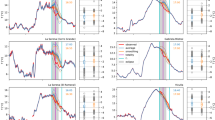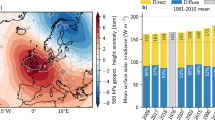Abstract
SEVERAL investigators have studied the variation of percentage occurrence of spread-F with sunspot number. Wells1 reported a decrease in the occurrence of spread-F with increasing sunspot activity at Huancayo. Considering the data for the period 1944–1951, Singleton2 observed an inverse correlation between the occurrence of spread-F and sunspot number at Brisbane. Kotadia3 found that at Ahmedabad spread-F occurrence decreases with increasing sunspot activity. These investigators have considered the data taken on all the days (in each month) in their studies. At Ibadan, Lyon et al.4 have shown that spread-F on quiet days reached a maximum value for high sunspot numbers. [Recently Rangaswamy and Kapasi5 studied the variation of spread-F occurrence with sunspot activity in each season taking data for the five quiet days in each month for the period 1957–1962 for Trivandrum, Kodaikanal, Ahmedabad and Yamagawa. At Kodaikanal, a well-defined positive correlation between the percentage occurrence and the sunspot number was observed by Rangaswany and Kapasi in all the seasons, while at Ahmedabad a negative correlation was found for summer and a positive one for all other seasons. No definite correlation could be established for the data of Trivandrum and Yamagawa. All these investigators have studied the qualitative aspect of the variation of spread-F occurrence with sunspot number. The purpose of the present investigation was to study quantitatively the dependence of the spread-F occurrence on sunspot number and its variation with latitude by analysing observations from a large number of stations both in the northern and southern hemispheres.
This is a preview of subscription content, access via your institution
Access options
Subscribe to this journal
Receive 51 print issues and online access
$199.00 per year
only $3.90 per issue
Buy this article
- Purchase on Springer Link
- Instant access to full article PDF
Prices may be subject to local taxes which are calculated during checkout
Similar content being viewed by others
References
Wells, H. W., J. Geophys. Res., 59, 66 (1954).
Singleton, D. G., Austral. J. Phys., 10, 60 (1957).
Kotadia, K. M., Proc. Ind. Acad. Sci., A, 50, 259 (1959).
Lyon, A. J., Skinner, N. J., and Wright, R. W. H., J. Atmos. Terr. Phys., 19, 145 (1960).
Rangaswamy, S., and Kapasi, K. B., J. Atmos. Terr. Phys., 25, 721 (1963).
Author information
Authors and Affiliations
Rights and permissions
About this article
Cite this article
KUMAR, V., RAO, B. Latitude Effect on the Variation of Spread-F Occurrence with Sunspot Number. Nature 207, 1083–1084 (1965). https://doi.org/10.1038/2071083a0
Published:
Issue Date:
DOI: https://doi.org/10.1038/2071083a0
Comments
By submitting a comment you agree to abide by our Terms and Community Guidelines. If you find something abusive or that does not comply with our terms or guidelines please flag it as inappropriate.



